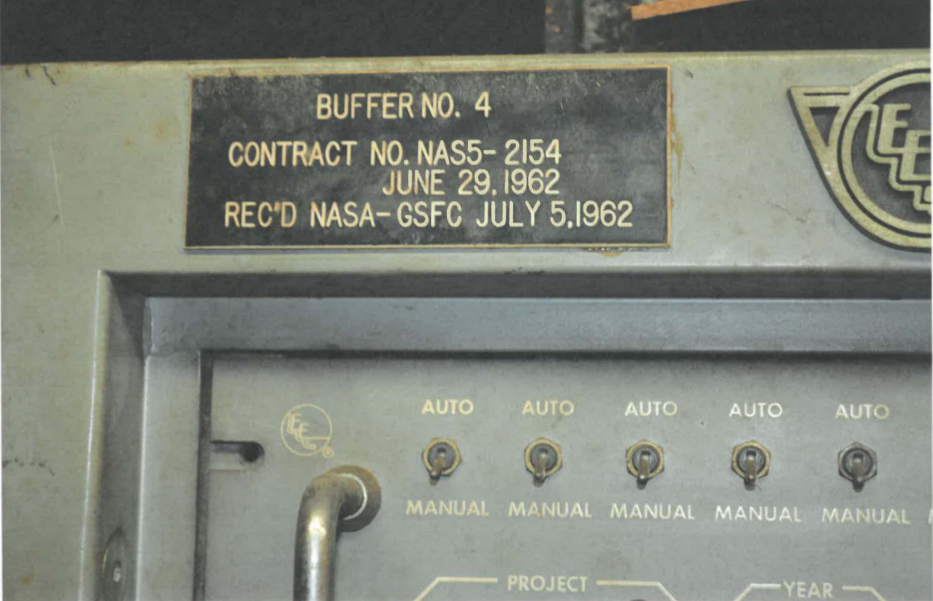
Private homes are good for many. One of the advantages of this house is the presence of an attic or basement. Often these places are used for storing unnecessary things like outdated or broken machinery, waste paper, conservation, etc. But sometimes really interesting things get into the basement, which, if they remember, years later. It happens that all this disappears forever, but it also happens that the representatives of the next generations already discover the once forgotten ancestors of the interesting, and quite unexpectedly.
That is what
happened in the United States, at the home of a deceased NASA employee. After his death, the relatives summoned the property appraiser. And this specialist, going down to the basement, saw an old technique similar to electronic computers of half a century old. As it turned out, these are really the computers used by NASA in the 60s of the last century.

The discovery was discovered at the turn of 2015 and 2016, but the story got public only now, more than a year later. Information leaked to the Internet thanks
to a NASA
report . The agency decided to study the situation and understand how two old computers got into the basement of the ex-employee. As it turned out, for the first time systems of this type began to operate in 1962, when the era of "Pioneers" began, replaced by the Apollo project. Together with computers, NASA representatives found 325 coils with magnetic tapes, which is even more valuable finding than the computers themselves.
Each of the old systems has the size of an average refrigerator. But these computers are much heavier than the refrigerator. How did one person deliver them to their home? None other than with the help of special mechanisms, including a crane. After a while, it turned out that computers were not stolen at all, they got into the basement in a completely legal manner. The fact is that their deceased owner, apart from NASA, also worked at IBM, in the late 60s and early 70s. At one time, both organizations took part in the development of joint projects, and the computers came to IBM, and on both machines it appears that it is the property of NASA. At that time, the computers were already outdated, and the corporation was going to get rid of them. The engineer asked if he could take the computer to himself, and he was agreed. Well, those same 325 films are just a nice bonus.

Entries were provided by NASA for thorough analysis. Some of them (small) were marked, some - not. From the marks of the tagged films, it was possible to find out that they contain information relating to such famous missions as Pioneer 10, Pioneer 11 (NASA missions to study Jupiter and Saturn) and Helios 1. Unmarked records have not yet been studied, there were 215 of them.
The films turned out to be really
valuable news from the past, and they were able to be transported to another place. But computers, despite their historical (and probably collectible) value, remained in the same basement, where they stood for more than half a century. The fact is that these systems, as mentioned above, are very heavy, almost unaffordable for humans. Therefore, conventional methods to remove them from the basement is simply impossible. For this, you would have to make a large hole in the foundation or even demolish a house to get to the basement.

As for the films, then, unfortunately, their preservation is not important - most of the records are damaged. Because of the dampness in the basement on the films constantly growing mold, and since no one cleaned them, the films were badly damaged. Those that were able to identify, refer to the projects "Pioneer 8", "Pioneer 9", "Pioneer 10", "Pioneer 11", "Helios 1", "Helios A", Intelsat IV.

Despite the fact that most of the details about the origin of computers and films for them could be clarified, there was one unresolved problem. The fact is that on computers their relation to the contract “NAS5-2154” is listed. NASA could not find a single record where this contract would be mentioned. In general, this is not so important, but it would be interesting to find out this moment as well.
The Pioneer program is an American program for the study of interplanetary space and a number of celestial bodies. As part of this project, several AMCs were launched. The most remarkable were the missions "Pioneer-10" and "Pioneer-11." The fact is that these devices could reach two of the outer planets of the solar system, as mentioned above. "Pioneers" began to launch in 1958. Pioneer 10 flew past Jupiter in December 1973. His main task was to study the conditions in the vicinity of Jupiter and detailed photographing of the planet. The last signal from Pioneer 10 was received on January 23, 2003. The Pioneer 11 flew past Jupiter in 1974 and continued flying. In 1979 he reached Saturn. In September 1995, contact with the device was lost.